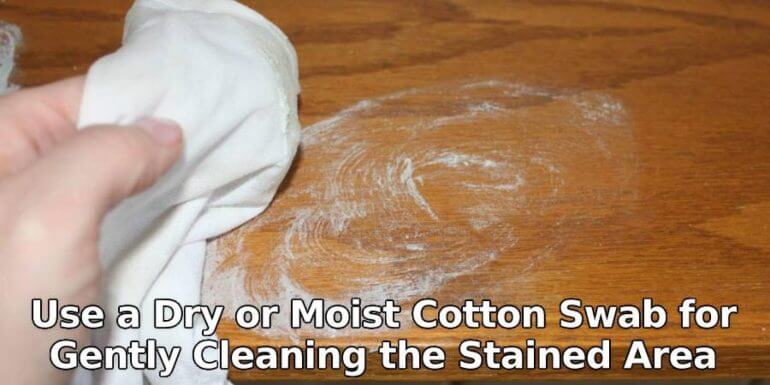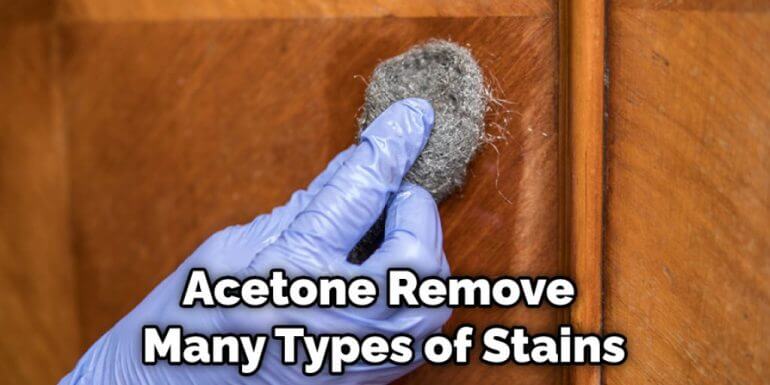If you’re dealing with an unsightly acetone stain on your wooden furniture or flooring, don’t panic. With the right approach, you can effectively fix this problem and restore the beauty of your wood surface. In this article, we will explore some simple and effective methods to remove acetone stains from wood, ensuring a flawless finish. Whether you’re a DIY enthusiast or a professional carpenter, these tips and techniques will help you tackle the issue with confidence.

Natural Remedies to Remove Acetone Stains from Wood
Accidental spills happen, and if you’ve ever accidentally spilled acetone on your wooden furniture or floors, you know how frustrating it can be. Acetone, commonly found in nail polish remover, can leave unsightly stains on wood if not dealt with quickly. However, before you reach for harsh chemicals or resort to sanding and refinishing, consider trying these natural remedies to remove acetone stains from wood.

1. Baking Soda and Water
Baking soda is a versatile household ingredient known for its cleaning properties. To remove acetone stains from wood, create a paste by mixing baking soda and water. Apply the paste directly to the stained area and gently scrub it using a soft cloth or sponge. Rinse the area with water and pat dry. Repeat the process if necessary.
2. Lemon Juice
Lemon juice is another effective natural remedy for removing acetone stains. Cut a lemon in half and squeeze the juice onto the stained area. Let it sit for a few minutes to allow the acidity of the lemon to break down the stain. Using a soft cloth, gently rub the stained area in a circular motion. Rinse with water and dry with a clean cloth.
3. Vinegar
Vinegar is a household staple known for its cleaning properties. Mix equal parts of white vinegar and water in a spray bottle. Spray the solution directly onto the acetone stain and let it sit for a few minutes. Gently scrub the stained area with a soft cloth or sponge, then rinse with water and pat dry.
4. Olive Oil
Olive oil not only adds flavor to your favorite dishes but also works wonders in removing acetone stains from wood. Apply a small amount of olive oil to a soft cloth and gently rub the stained area in a circular motion. The oil will help lift the stain while moisturizing the wood. Wipe off any excess oil with a clean cloth.
5. Toothpaste
Toothpaste, especially the non-gel type, can be used to remove acetone stains from wood. Apply a small amount of toothpaste to the stained area and gently rub it using a soft cloth or sponge. Rinse with water and dry with a clean cloth. Toothpaste contains mild abrasives that can help lift the stain without damaging the wood surface.
It’s always important to test any of these natural remedies on a small, inconspicuous area of the wood before applying them to the stained area. If you notice any adverse effects, discontinue use immediately.
Summary
Removing acetone stains from wood doesn’t have to be a daunting task. With these natural remedies, you can effectively eliminate the stains without the need for harsh chemicals or extensive sanding. Whether it’s baking soda, lemon juice, vinegar, olive oil, or toothpaste, these household items can come to the rescue and restore the beauty of your wooden surfaces.

Preventing and Avoiding Acetone Stains on Wood Surfaces
Wood surfaces are known for their natural beauty and durability. However, they are also susceptible to various stains and damage if not properly cared for. One common issue that many people face is the occurrence of acetone stains on wood surfaces. Acetone, a common solvent used in many household products, can cause unsightly stains on wood if not handled carefully. In this section, we will discuss some effective methods to prevent and avoid acetone stains on wood surfaces.
1. Protect the Wood Surface
The first step in preventing acetone stains on wood surfaces is to protect the wood itself. This can be done by applying a protective finish or sealant to the surface, such as varnish or polyurethane. These finishes create a barrier that prevents the acetone from penetrating the wood and causing stains. It is important to regularly inspect the finish and reapply it if necessary to maintain its effectiveness.
2. Use Protective Measures
When working with acetone near wood surfaces, it is essential to take proper precautions. One of the best ways to prevent stains is to use a drop cloth or plastic sheeting to cover the wood surface. This will catch any spills or splatters and prevent them from coming into direct contact with the wood. Additionally, wearing protective gloves and eyewear can help minimize the chances of accidental spills or splashes.
3. Clean Up Spills Immediately
In the event of an acetone spill on a wood surface, it is crucial to act quickly and clean it up immediately. Use a clean cloth or paper towel to blot the spilled acetone, avoiding any rubbing or spreading of the liquid. If the acetone has already penetrated the wood and caused a stain, you can try using a mild wood cleaner or vinegar solution to gently remove the stain. However, be cautious to test these solutions on a small, inconspicuous area first to ensure they do not further damage the wood.
4. Handle Acetone Safely
Proper handling and storage of acetone can also help prevent stains on wood surfaces. When not in use, ensure that acetone containers are tightly sealed to prevent evaporation and spills. Store acetone in a cool, dry place away from direct sunlight and sources of heat. It is also important to follow any safety guidelines and recommendations provided by the manufacturer.
5. Seek Professional Help
If you are unsure about how to prevent or remove acetone stains from a wood surface, it is best to seek professional help. A wood restoration specialist or furniture refinisher can provide expert advice and assistance in treating and restoring acetone-damaged wood. They have the knowledge and experience to handle such situations effectively and minimize any potential damage.
In summary, preventing and avoiding acetone stains on wood surfaces requires proactive measures and proper handling. Protecting the wood surface with a suitable finish, using protective measures during work, prompt clean-up of spills, safe handling of acetone, and seeking professional help when needed are all essential in maintaining the beauty and integrity of wood surfaces.

Professional Tips for Removing Stubborn Acetone Stains on Wood
Wood is a beautiful and versatile material that adds warmth and elegance to any space. However, accidents happen, and sometimes we may spill acetone on wooden surfaces. Acetone is a powerful solvent commonly used in nail polish removers, paint thinners, and adhesives.
Acetone can quickly penetrate the wood, causing stains that can be difficult to remove. If you find yourself dealing with stubborn acetone stains on wood, don’t panic. With the right techniques and a little patience, you can effectively remove these stains and restore the beauty of your wooden surfaces.
1. Act Quickly
When it comes to removing acetone stains from wood, time is of the essence. The sooner you take action, the better your chances of success. As soon as you notice the stain, grab a clean cloth or paper towel and blot the area gently to absorb as much acetone as possible. Avoid rubbing or spreading the stain, as this may cause it to set deeper into the wood.
2. Test in an Inconspicuous Area
Before applying any cleaning products or solutions to the stained wood, it’s essential to test them in an inconspicuous area. This will help you ensure that the product or solution does not cause further damage or discoloration to the wood. Apply a small amount of the product to a hidden area and observe for any adverse reactions.
3. Use Dish Soap and Warm Water
One of the simplest and most effective solutions for removing acetone stains on wood is a mixture of dish soap and warm water. Start by diluting a few drops of mild dish soap in a bowl of warm water. Dip a clean cloth into the soapy solution, wring out any excess liquid, and gently blot the stained area. Rinse the cloth frequently to avoid spreading the stain. Continue blotting until the stain fades or disappears completely.
4. Try Vinegar
Vinegar is a natural and versatile cleaning agent that can be used to remove a variety of stains, including acetone stains on wood. Mix equal parts of white vinegar and water in a bowl. Dip a clean cloth into the vinegar solution, wring out excess liquid, and gently dab the stained area. Allow the vinegar solution to sit on the stain for a few minutes, then blot with a clean cloth. Repeat the process as necessary until the stain is gone.
5. Use Denatured Alcohol
If the acetone stain persists, you can try using denatured alcohol. Denatured alcohol is a stronger solvent that can help break down the stain. Apply a small amount of denatured alcohol to a clean cloth and gently blot the stained area. Avoid rubbing, as this may damage the wood. Rinse the cloth frequently and continue blotting until the stain is removed.
6. Sand and Refinish
In extreme cases where the acetone stain cannot be completely removed, you may need to consider sanding and refinishing the affected area. This should be a last resort, as it involves more extensive work. Use a fine-grit sandpaper to sand away the stained layer of wood, taking care to blend the sanded area with the surrounding wood. Once the stain is removed, apply a wood finish or sealant to protect and restore the wood’s appearance.
In summary, removing stubborn acetone stains on wood requires prompt action and the right techniques. By acting quickly, testing cleaning solutions, and utilizing methods such as dish soap and warm water, vinegar, or denatured alcohol, you can effectively remove these stains. In more severe cases, sanding and refinishing may be necessary to restore the wood’s original beauty. With these professional tips, you can confidently tackle and remove stubborn acetone stains on wood.
DIY Solutions for Restoring the Natural Beauty of Wood after Acetone Stains
Wood is a versatile and beautiful material that adds warmth and character to any space. However, accidents happen, and sometimes we end up with unsightly stains on our beloved wooden furniture or floors. Acetone is a commonly used chemical that can accidentally come into contact with wood, leaving behind stubborn stains. The good news is that you don’t have to live with these stains forever. With some simple DIY solutions, you can restore the natural beauty of wood and make it look brand new again.
1. Sanding
Sanding is often the go-to solution for removing stains from wood. It involves using sandpaper or a sanding block to gently sand away the stained surface layer of the wood. To start, choose a sandpaper with a grit between 120 and 220. Gently sand the stained area in the direction of the wood grain until the stain disappears. Be careful not to apply too much pressure, as it can damage the wood. Once the stain is gone, wipe away any dust with a clean cloth and finish with a layer of wood polish or varnish to protect the newly restored surface.
2. Oxalic Acid Solution
If sanding alone doesn’t completely remove the acetone stain, you can try using an oxalic acid solution. Oxalic acid is a powerful stain remover commonly used for wood restoration. Start by wearing gloves and protective eyewear, as oxalic acid can be harmful if not handled correctly. Mix the oxalic acid powder with water according to the manufacturer’s instructions to create a paste. Apply the paste to the stained area and let it sit for about 10 minutes. Then, using a damp cloth, gently rub the area until the stain fades away. Rinse the area with clean water and dry it thoroughly. Finish by applying a wood polish or varnish to protect the wood.
3. Baking Soda and Water Paste
Baking soda is a versatile household ingredient that can also help remove acetone stains from wood. Create a paste by mixing baking soda with water until it forms a thick consistency. Apply the paste to the stained area and let it sit for a few minutes. Then, using a soft cloth or sponge, gently scrub the stain in a circular motion. Rinse the area with clean water and dry it thoroughly. If the stain persists, repeat the process until the stain is completely gone. Once the stain is removed, apply a wood polish or varnish to restore the wood’s natural shine.
4. Lemon Juice and Olive Oil Mixture
Lemon juice and olive oil can work together to remove acetone stains while nourishing the wood. Mix equal parts lemon juice and olive oil in a small bowl. Using a soft cloth, apply the mixture to the stained area and gently rub it in. Let it sit for a few minutes to penetrate the stain. Then, using a clean cloth, wipe away the mixture and rinse the area with water. Dry the wood thoroughly and apply a layer of wood polish or varnish to protect and enhance the wood’s natural beauty.
5. Hydrogen Peroxide Solution
Hydrogen peroxide is a mild bleaching agent that can effectively remove acetone stains from wood. Begin by diluting hydrogen peroxide with water in a 1:1 ratio. Soak a clean cloth in the solution and wring out any excess liquid. Place the cloth on the stained area and let it sit for about 10 minutes. Remove the cloth and gently scrub the stain with a soft brush or sponge. Rinse the area with clean water and dry it thoroughly. Apply a wood polish or varnish to restore the wood’s shine and protect it from future damage.
In summary, removing acetone stains from wood doesn’t have to be a daunting task. With these simple DIY solutions, you can restore the natural beauty of wood and enjoy your furniture or floors for years to come. Whether you choose to sand, use an oxalic acid solution, a baking soda and water paste, a lemon juice and olive oil mixture, or a hydrogen peroxide solution, always remember to protect yourself by wearing gloves and eyewear and to follow the instructions carefully. Happy restoring!
FAQs
How to fix acetone stain on wood?
To fix an acetone stain on wood, first, gently sand the affected area to remove the stain. Then, apply a wood stain or polish that matches the color of the surrounding wood. Allow it to dry completely before applying a sealant or varnish to protect the wood.
Conclusion
In conclusion, fixing an acetone stain on wood can be a straightforward process if approached with the right techniques. By following the steps outlined in this guide, you can effectively remove or minimize the appearance of the stain. Remember to always test any cleaning or repair method on a small, inconspicuous area of the wood first to ensure it doesn’t cause further damage. Additionally, prevention is key to avoiding acetone stains in the first place. Be cautious when using acetone-based products near wooden surfaces and consider using protective barriers or covering the wood to prevent accidents. With patience and care, you can restore the beauty of your wood surfaces and enjoy them for years to come.
Whether it’s a small blemish or a larger, more noticeable stain, addressing acetone stains on wood promptly is essential for maintaining the aesthetics and value of your furniture or flooring. Always approach the cleaning and repair with caution, using appropriate tools and techniques to avoid further damage. In some cases, seeking professional help may be the best course of action, especially if the stain is extensive or has deeply penetrated the wood. Remember to follow the manufacturer’s recommendations for cleaning and maintenance, as well as any additional precautions specific to your type of wood. With diligence and proper care, you can successfully fix acetone stains on wood and restore its original appearance.